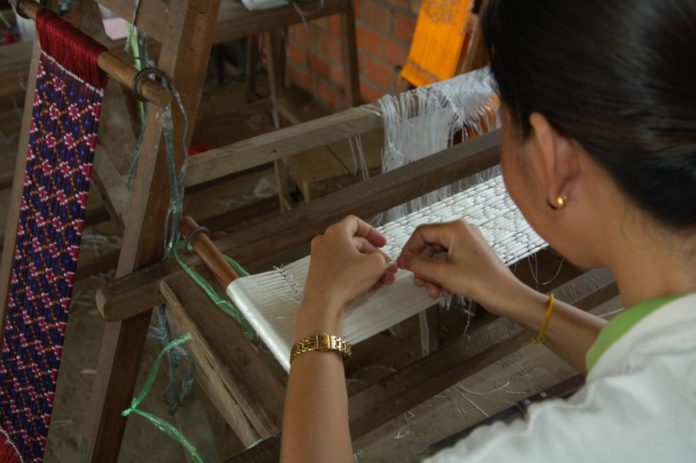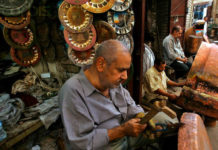Ikat technique: Beginning the binding process (ikat technique) before first dyeing step
Hôl lboeuk is a Khmer expression that describes a distinctive type of silk fabric that is usually worn during official ceremonies in Cambodia. The words hôl and lboeuk explain how this fabric is made.
Hôl is the result of the ikat technique, a method that enables coloured designs to appear during the weaving process. Ikat employs a resist dyeing process, by means of bindings, similar to tie-dye, on the weft threads. Skeins of silk are set up onto a tying-in frame; strands, which resist dye penetration, are tied on the threads in the desired patterns that are required on the final fabric. After each tying-in process, the silk threads are taken from the frame for dyeing. Ligatures and masking are used to prevent cross colouring or to keep certain parts un-dyed. The tying-in frame is then reset for the subsequent dyeing operations, enabling the weaver to produce designs that are frequently geometric or floral. When all steps of dyeing are finished, the bindings are removed and the threads are ready to be woven into cloth.

Ikat technique: second part of the binding process. The threads have already been dyed once so the first bindings have to be removed; new bindings have to be set-up following a predetermined shape; then the threads will be dyed again.

Result of the ikat technique: these silk threads have been dyed several times at different parts and are now ready to be woven.
Lboeuk is the diamond motif that results from brocade, a supplementary weft technique. The weaver uses multiple frames of the loom to add geometrical reliefs that were planned ahead when preparing the loom. The motifs in relief are produced by a supplementary, non-structural, weft in addition to the standard weft that holds the warp threads together. The purpose of this method is to give the appearance that the weave actually was embroidered on.
Hôl lboeuk is the result of these two complex and time-consuming techniques combined on the same fabric. For the weavers, it involves at the same time weaving each thread, one by one, into the base colour until the motif appears, and using multiple frames of the loom to add geometrical motifs in relief.

The geometrical coloured patterns appear on the fabric thanks to the threads which were individually dyed in multiple colours.




